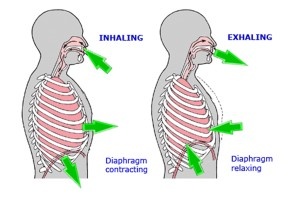- Home
- 7 Steps of Goal Setting
- Breathing Exercises
Breathing Exercises for Stress Relief
One of the most effective stress management techniques is right under your nose.
Breathing exercises are a simple and effective way to deal with stress. Most breathing techniques for stress relief involve diaphragmatic breathing that activates the parasympathetic nervous system.
As a kid, I remember visiting the doctor who told me to take a deep breath as he placed the stethoscope on my chest.

If you were anything like me, you probably took a deep breath as you raised your shoulders and puffed out your chest.
Right? Wrong!
Deep breathing from the belly rather than the chest is a better way to breathe for increased oxygen and enhanced relaxation.
Here we provide a couple of deep breathing exercises for stress relief.
A 7-11 breathing exercise
With 7-11 breathing, you begin to reverse this process quickly making you calm and relaxed.
By learning to breathe with 7-11 you will relax and calm yourself to deal better with stressful situations, such as taking an exam and public speaking.
When you get used to the 7-11 breathing pattern, you instinctively relax.
Relax anytime, any place with the 7-11 Breathing tip.
Stress and Your Body
When stressed, you body initiates the fight or flight response. Glucocorticoids are released which inhibits the formation of white blood cells, namely the B and T cells, and suppresses the immune system.
This is one of the reasons for a strong link between stress and health.
Diaphragmatic breathing technique
Have you noticed that when you are stressed, you breathe rapidly and shallowly from the chest. This is a common stress symptom.
Here we are going to explain diaphragmatic breathing. This breathing technique is the basis of many breathing exercises.
But before you start, why not check out your breathing rate? Count how many inhalations you take over the next minute.
If you are breathing from the chest you are likely to be taking more than 10 breaths per minute.
Five minutes of breathing from the diaphragm is a helpful start to reduce the effects of shallow breathing.
High breathing rates may lead to an imbalance in oxygen and carbon levels in the blood and this may result in increased anxiety, tension, and a faster heart rate.
Steps in learning diaphragmatic breathing

- Stand or sit in comfortable position with a straight back
- Slowly breathe in through your nose and count to 5. As you do this feel your belly expand while your chest remains relatively still
- Slowly breathe out through your mouth counting slowly to 8. While breathing out feel your stomach muscles contract while your chest remains relatively still
- Repeat this four more times.


New! Comments
Have your say about what you just read! Leave me a comment in the box below.